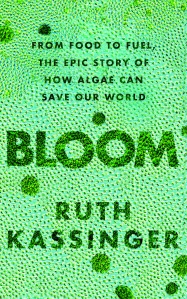 The first things I think of when I hear the word “algae” are the microscopic green cells that were the ancestors of land plants. Reading Bloom by Ruth Kassinger was a powerful reminder that algae are so much more than this. The term “algae” actually describes a diverse collection of lifeforms ranging from single-celled diatoms to kelp and other seaweeds*. In the book, the author explores the origins of algae, their modern uses in food and other products, and the emerging algae-based technologies that may help us save the planet in future.
The first things I think of when I hear the word “algae” are the microscopic green cells that were the ancestors of land plants. Reading Bloom by Ruth Kassinger was a powerful reminder that algae are so much more than this. The term “algae” actually describes a diverse collection of lifeforms ranging from single-celled diatoms to kelp and other seaweeds*. In the book, the author explores the origins of algae, their modern uses in food and other products, and the emerging algae-based technologies that may help us save the planet in future.
Kassinger strikes a good balance between scientific detail and storytelling so that the text is approachable and not too technical. I especially enjoyed how the text mixes descriptive passages with accounts of the author’s meetings with algae growers, scientists and entrepreneurs. The book is perhaps a bit long winded in places but I don’t think this detracts from the author’s message. I am looking forward to seeing how the technologies and products highlighted in the book develop in the future.
Bloom by Ruth Kassinger
Elliott & Thompson, ISBN: 9781783964413, hardback Jul 2019
(Published in the US under the title Slime by Houghton Mifflin Harcourt in June 2019)
*It is worth noting that there is no generally accepted definition of algae. Traditionally a group of bacteria known as cyanobacteria (also known as blue-green algae) were also considered to be algae, but today many scientists reserve the term “algae” for the non-bacterial species. In Bloom, Kassinger uses the older definition and there is a section on the rise of cyanobacteria.
Interesting. I googled this book and found out that the title in the US is “Slime”. I wonder why they changed it. An algal bloom in the US is when algae grows out of control and uses up the oxygen in a body of water. Do they not use the tern the same way in the UK? Or maybe “slime” isn’t used as a term for algae in the UK?
Yeah I was intrigued by the name change too. I personally wouldn’t think ‘algae’ on seeing the word ‘slime’ so maybe it is a US/UK English thing.